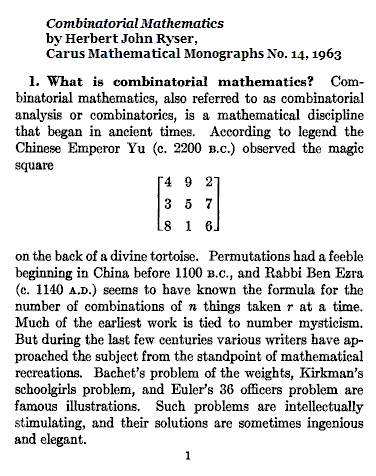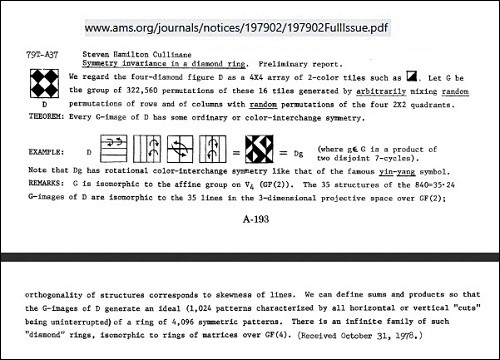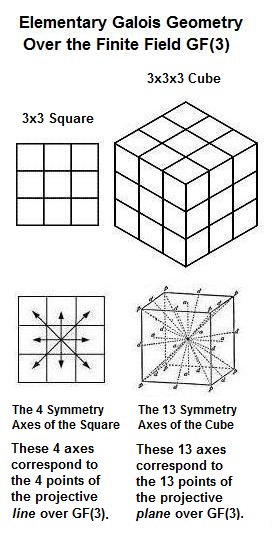"The bride hath paced into the hall,
Red as a rose is she;
Nodding their heads before her goes
The merry minstrelsy."
Wednesday, May 8, 2024
Art Grid: A Fulcrum for Pullman
Tuesday, December 21, 2021
Grid Language, Grid Logic
Thursday, April 15, 2021
Grid View and List View
From AntiChristmas 2010 —

Above: Art Theorist Rosalind Krauss and The Ninefold Square
For Krauss:
![]()
Grid View List View
Wednesday, October 18, 2017
Three Small Grids
An earlier post today, now tagged "Three Small Magic Squares,"
suggests a review of a post from October 25 three years ago
that contains the following figure —

Fans of the October Revolution may enjoy a passage
by Rosalind Krauss on grids:

Wednesday, March 26, 2014
Saturday, January 8, 2011
True Grid (continued)
"Rosetta Stone" as a Metaphor
in Mathematical Narratives
For some backgound, see Mathematics and Narrative from 2005.
Yesterday's posts on mathematics and narrative discussed some properties
of the 3×3 grid (also known as the ninefold square ).
For some other properties, see (at the college-undergraduate, or MAA, level)–
Ezra Brown, 2001, "Magic Squares, Finite Planes, and Points of Inflection on Elliptic Curves."
His conclusion:
When you are done, you will be able to arrange the points into [a] 3×3 magic square,
which resembles the one in the book [5] I was reading on elliptic curves….
This result ties together threads from finite geometry, recreational mathematics,
combinatorics, calculus, algebra, and number theory. Quite a feat!
5. Viktor Prasolov and Yuri Solvyev, Elliptic Functions and Elliptic Integrals ,
American Mathematical Society, 1997.
Brown fails to give an important clue to the historical background of this topic —
the word Hessian . (See, however, this word in the book on elliptic functions that he cites.)
Investigation of this word yields a related essay at the graduate-student, or AMS, level–
Igor Dolgachev and Michela Artebani, 2009, "The Hesse Pencil of Plane Cubic Curves ."
From the Dolgachev-Artebani introduction–
In this paper we discuss some old and new results about the widely known Hesse
configuration of 9 points and 12 lines in the projective plane P2(k ): each point lies
on 4 lines and each line contains 3 points, giving an abstract configuration (123, 94).
PlanetMath.org on the Hesse configuration—

A picture of the Hesse configuration–

(See Visualizing GL(2,p), a note from 1985).
Related notes from this journal —
From last November —
|
From the December 2010 American Mathematical Society Notices—
Related material from this journal— Consolation Prize (August 19, 2010) |
From 2006 —
|
Sunday December 10, 2006
“Function defined form, expressed in a pure geometry
– J. G. Ballard on Modernism
“The greatest obstacle to discovery is not ignorance –
— Daniel J. Boorstin, |
Also from 2006 —
|
Sunday November 26, 2006
Rosalind Krauss "If we open any tract– Plastic Art and Pure Plastic Art or The Non-Objective World , for instance– we will find that Mondrian and Malevich are not discussing canvas or pigment or graphite or any other form of matter. They are talking about Being or Mind or Spirit. From their point of view, the grid is a staircase to the Universal, and they are not interested in what happens below in the Concrete. Or, to take a more up-to-date example…."
"He was looking at the nine engravings and at the circle,
"And it's whispered that soon if we all call the tune
The nine engravings of The Club Dumas
An example of the universal*– or, according to Krauss,
"This is the garden of Apollo, the field of Reason…."
For more on the field of reason, see
A reasonable set of "strange correspondences" Unreason is, of course, more popular. * The ninefold square is perhaps a "concrete universal" in the sense of Hegel: "Two determinations found in all philosophy are the concretion of the Idea and the presence of the spirit in the same; my content must at the same time be something concrete, present. This concrete was termed Reason, and for it the more noble of those men contended with the greatest enthusiasm and warmth. Thought was raised like a standard among the nations, liberty of conviction and of conscience in me. They said to mankind, 'In this sign thou shalt conquer,' for they had before their eyes what had been done in the name of the cross alone, what had been made a matter of faith and law and religion– they saw how the sign of the cross had been degraded."
– Hegel, Lectures on the History of Philosophy ,
"For every kind of vampire, |
And from last October —
|
Friday, October 8, 2010
Starting Out in the Evening This post was suggested by last evening's post on mathematics and narrative and by Michiko Kakutani on Vargas Llosa in this morning's New York Times .
"One must proceed cautiously, for this road— of truth and falsehood in the realm of fiction— is riddled with traps and any enticing oasis is usually a mirage."
– "Is Fiction the Art of Lying?"* by Mario Vargas Llosa,
* The Web version's title has a misprint— |
Sunday, September 8, 2024
Sunday Morning Koppel
Today's host for a special political edition of CBS Sunday Morning
is Ted Koppel. Vocabulary review:

Koppel's appearance today was backed by the usual CBS Sunday Morning
sun-disk Apollo symbol. An Apollo symbol that some may prefer —
The Ninefold Square
|
Rosalind Krauss "If we open any tract– Plastic Art and Pure Plastic Art or The Non-Objective World , for instance– we will find that Mondrian and Malevich are not discussing canvas or pigment or graphite or any other form of matter. They are talking about Being or Mind or Spirit. From their point of view, the grid is a staircase to the Universal, and they are not interested in what happens below in the Concrete. Or, to take a more up-to-date example…."
"He was looking at the nine engravings and at the circle,
"And it's whispered that soon if we all call the tune
The nine engravings of The Club Dumas
An example of the universal— or, according to Krauss,
"This is the garden of Apollo, the field of Reason…." |
Wednesday, May 15, 2024
Passage for a Merry Minstrel: The Script Page*
"The bride hath paced into the hall,
Red as a rose is she;
Nodding their heads before her goes
The merry minstrelsy."
* The title is from the following passage . . .
Tuesday, April 2, 2024
For Harlan Kane: The Rothfeld Explanation

Earlier . . .
A Riddler Wannabe —
Related material — The Krauss passage quoted as above
by Shechtman in The New Yorker in December 2021 appears
also in a Log24 post of October 18, 2017: "Three Small Grids."
Tuesday, December 27, 2022
The Forms of Being
"If the window is this matrix of ambi- or multivalence,
and the bars of the windows-the grid-are what help us
to see, to focus on, this matrix, they are themselves
the symbol of the symbolist work of art. They function as
the multilevel representation through which the work of art
can allude, and even reconstitute, the forms of Being."
— Page 59, Rosalind Krauss, "Grids," MIT Press,
October , Vol. 9 (Summer, 1979), pp. 50-64
Related material —
Click the above image for a related Log24 post of 15 years ago today.
A related literary remark —
"Imagine Raiders of the Lost Ark set in 20th-century London, and then
imagine it written by a man steeped not in Hollywood movies but in Dante
and the things of the spirit, and you might begin to get a picture…."
— Doug Thorpe in an Amazon.com book review, not of Dark Materials.
Saturday, December 24, 2022
Window as Matrix
Grids
Author: Rosalind Krauss
Source: October , Vol. 9 (Summer, 1979), pp. 50-64
Published by: The MIT Press
Stable URL: http://www.jstor.org/stable/778321
From page 59:
"Flowing and freezing; glace in French means glass, mirror, and ice;
transparency, opacity, and water. In the associative system
of symbolist thought this liquidity points in two directions.
First, towards the flow of birth-the amniotic fluid, the 'source'-
but then, towards the freezing into stasis or death-
the unfecund immobility of the mirror. For Mallarmé, particularly,
the window functioned as this complex, polysemic sign by which
he could also project the 'crystallization of reality into art.' 5
Mallarmé's Les Fenêtres dates from 1863;
Redon's most evocative window, Le Jour , appeared in 1891
in the volume Songes . If the window is this matrix of
ambi- or multivalence, and the bars of the windows-the grid-
are what help us to see, to focus on, this matrix, they are
themselves the symbol of the symbolist work of art.
They function as the multilevel representation through which
the work of art can allude, and even reconstitute, the forms of Being."
5 Robert G. Cohn, "Mallarmé's Windows," Yale French Studies ,
no. 54 (1977), 23-31.
Another evocative example — See Galois Window in this journal.
Friday, December 23, 2022
“Was ist Raum?” — Bauhaus Founder Walter Gropius

"Was ist Raum, wie können wir ihn
erfassen und gestalten?"
The Theory and
Organization of the
Bauhaus (1923)
A relevant illustration:
At math.stackexchange.com on March 1-12, 2013:
“Is there a geometric realization of the Quaternion group?” —
The above illustration, though neatly drawn, appeared under the
cloak of anonymity. No source was given for the illustrated group actions.
Possibly they stem from my Log24 posts or notes such as the Jan. 4, 2012,
note on quaternion actions at finitegeometry.org/sc (hence ultimately
from my note “GL(2,3) actions on a cube” of April 5, 1985).
These references will not appeal to those who enjoy modernism as a religion.
(For such a view, see Rosalind Krauss on grids and another writer's remarks
on the religion's 100th anniversary this year.)
Some related nihilist philosophy from Cormac McCarthy —
"Forms turning in a nameless void."
Thursday, December 22, 2022
For “Dark Materials” Fans: The Monkey Trial
Wednesday, December 21, 2022
The Unmagic Square
Last year on this date:
A Riddler Wannabe —
Related material — The Krauss passage quoted as above
by Shechtman in The New Yorker in December 2021 appears
also in a Log24 post of October 18, 2017: "Three Small Grids."
Tuesday, November 9, 2021
Gestalt für Schicksalstag
"… thinking starts with a problem, a difficulty, a contradiction."
— The late Arthur Mattuck of MIT in last night's post Gestalt .
"The 'technical support' is an underlying ground for aesthetic practice
that supports the work of art as canvas supported oil paint."
— MIT Press on the book by Rosalind Krauss titled Under Blue Cup .
From Grid View and List View (Log24, 15 April 2021) —

Tuesday, August 10, 2021
Ex Fano Apollinis
|
Margaret Atwood on Lewis Hyde's "Trickster is among other things the gatekeeper who opens the door into the next world; those who mistake him for a psychopath never even know such a door exists." (159) What is "the next world"? It might be the Underworld…. The pleasures of fabulation, the charming and playful lie– this line of thought leads Hyde to the last link in his subtitle, the connection of the trickster to art. Hyde reminds us that the wall between the artist and that American favourite son, the con-artist, can be a thin one indeed; that craft and crafty rub shoulders; and that the words artifice, artifact, articulation and art all come from the same ancient root, a word meaning "to join," "to fit," and "to make." (254) If it’s a seamless whole you want, pray to Apollo, who sets the limits within which such a work can exist. Tricksters, however, stand where the door swings open on its hinges and the horizon expands: they operate where things are joined together, and thus can also come apart. |
"As a Chinese jar . . . ."
— Four Quartets
|
Rosalind Krauss "If we open any tract– Plastic Art and Pure Plastic Art or The Non-Objective World , for instance– we will find that Mondrian and Malevich are not discussing canvas or pigment or graphite or any other form of matter. They are talking about Being or Mind or Spirit. From their point of view, the grid is a staircase to the Universal, and they are not interested in what happens below in the Concrete. Or, to take a more up-to-date example…."
"He was looking at the nine engravings and at the circle,
"And it's whispered that soon if we all call the tune
The nine engravings of The Club Dumas
An example of the universal— or, according to Krauss,
"This is the garden of Apollo, |
The "Katz" of the August 7 post Art Angles
is a product of Princeton's
Department of Art and Archaeology.
ART —
ARCHAEOLOGY —

"This pattern is a square divided into nine equal parts.
It has been called the 'Holy Field' division and
was used throughout Chinese history for many
different purposes, most of which were connected
with things religious, political, or philosophical."
– The Magic Square: Cities in Ancient China,
by Alfred Schinz, Edition Axel Menges, 1996, p. 71
Thursday, March 4, 2021
Teaching the Academy to See
“Art bears the same relationship to society
that the dream bears to mental life. . . .
Like art, the dream mediates between order
and chaos. So, it is half chaos. That is why
it is not comprehensible. It is a vision, not
a fully fledged articulated production.
Those who actualize those half-born visions
into artistic productions are those who begin
to transform what we do not understand into
what we can at least start to see.”
— A book published on March 2, 2021:
Beyond Order , by Jordan Peterson
The inarticulate, in this case, is Rosalind Krauss:
A “raid on the inarticulate” published in Notices of the
American Mathematical Society in the February 1979 issue —
Wednesday, March 3, 2021
Ink
From this journal on Nov. 9-12, 2004:
|
Fade to Black “…that ineffable constellation of talents that makes the player of rank: a gift for conceiving abstract schematic possibilities; a sense of mathematical poetry in the light of which the infinite chaos of probability and permutation is crystallized under the pressure of intense concentration into geometric blossoms; the ruthless focus of force on the subtlest weakness of an opponent.” — Trevanian, Shibumi “‘Haven’t there been splendidly elegant colors in Japan since ancient times?’ ‘Even black has various subtle shades,’ Sosuke nodded.” — Yasunari Kawabata, The Old Capital An Ad Reinhardt painting described in the entry of
Ad Reinhardt, Abstract Painting, 1960-66. The viewer may need to tilt the screen to see that “The grid is a staircase to the Universal…. We could think about Ad Reinhardt, who, despite his repeated insistence that ‘Art is art,’ ended up by painting a series of… nine-square grids in which the motif that inescapably emerges is a Greek cross.  Greek Cross There is no painter in the West who can be unaware of the symbolic power of the cruciform shape and the Pandora’s box of spiritual reference that is opened once one uses it.” — “Grids,” by Rosalind Krauss, |
Related material from The New York Times today —
Monday, February 17, 2020
RIP Charles Portis
See also "True Grid " in this journal.
|
Rosalind Krauss "If we open any tract– Plastic Art and Pure Plastic Art or The Non-Objective World , for instance– we will find that Mondrian and Malevich are not discussing canvas or pigment or graphite or any other form of matter. They are talking about Being or Mind or Spirit. From their point of view, the grid is a staircase to the Universal, and they are not interested in what happens below in the Concrete. Or, to take a more up-to-date example…."
"He was looking at the nine engravings and at the circle,
"And it's whispered that soon if we all call the tune
The nine engravings of The Club Dumas
An example of the universal— or, according to Krauss,
"This is the garden of Apollo, the field of Reason…." |
See as well . . .
Sunday, July 9, 2017
Sunday School Lesson
"The Occult Roots of Modernism," by Alex Ross,
in the June 26, 2017, issue of The New Yorker .
A related illustration —
Wednesday, January 4, 2017
A Drama of Many Forms
According to art historian Rosalind Krauss in 1979,
the grid's earliest employers
"can be seen to be participating in a drama
that extended well beyond the domain of art.
That drama, which took many forms, was staged
in many places. One of them was a courtroom,
where early in this century, science did battle with God,
and, reversing all earlier precedents, won."
The previous post discussed the 3×3 grid in the context of
Krauss's drama. In memory of T. S. Eliot, who died on this date
in 1965, an image of the next-largest square grid, the 4×4 array:

See instances of the above image.
Tuesday, January 3, 2017
Cultist Space
The image of art historian Rosalind Krauss in the previous post
suggests a review of a page from her 1979 essay "Grids" —

The previous post illustrated a 3×3 grid. That cultist space does
provide a place for a few "vestiges of the nineteenth century" —
namely, the elements of the Galois field GF(9) — to hide.
See Coxeter's Aleph in this journal.
Ein Eck…
By a disciple of the late John Berger —
For further ideological remarks from this source, see the now-defunct
web journal Everyday Analysis: An International Collective.
For further remarks from the date of the above post, October 9, 2013,
see this journal on that date.

Wednesday, January 7, 2015
Gitterkrieg
(Continued from Jan. 3 and Jan. 5.)
Introduction: "Grids, You Say?" by Josefine Lyche,
and AntiChristmas 2010:

Related material:
Chapter 42 in
A History of Graphic Design ,
by Guity Novin.
Tuesday, October 21, 2014
Art as a Tool
Two news items on art as a tool:
Two Log24 posts related to the 3×3 grid, the underlying structure for China’s
ancient Lo Shu “magic” square:
Finally, leftist art theorist Rosalind Krauss in this journal
on AntiChristmas, 2010:

Which is the tool here, the grid or Krauss?
Saturday, October 18, 2014
Educational Series
Barron's Educational Series (click to enlarge):
The Tablet of Ahkmenrah:

"With the Tablet of Ahkmenrah and the Cube of Rubik,
my power will know no bounds!"
— Kahmunrah in a novelization of Night at the Museum:
Battle of the Smithsonian , Barron's Educational Series
Another educational series (this journal):
Thursday, August 14, 2014
Full Frontal Aesthetics
A prequel to today's noon post
Rosalind Krauss in "Grids" —
"The physical qualities of the surface, we could say,
are mapped onto the aesthetic dimensions of
the same surface. And those two planes—
the physical and the aesthetic— are demonstrated
to be the same plane…. the bottom line of the grid is
a naked and determined materialism.”
A writer I prefer:

Barsotti's classic illustrated:
The naked and determined Annette Bening in "The Grifters" —

Bottom Line
“. . . the bottom line of the grid is a naked and determined materialism.”
— Rosalind Krauss, quoted by Josefine Lyche
See also http://www.dailymotion.com/video/
x164rmi_britt-ekland-nude-wicker-man-1973_people.
Wednesday, October 9, 2013
To Apollo*
Sunday, April 28, 2013
Red October’s Sermon
… For the Harvard Arts Weekend:
"Grids, You Say?" by Josefine Lyche, with
Lyche's quotation from Rosalind Krauss in October
(Vol. 9, Summer 1979) —
 |
See also last evening's Elevation of the Host, with Vampire Weekend.
"For every kind of vampire, there is a kind of cross." — Gravity's Rainbow
Tuesday, October 30, 2012
Black October
From AntiChristmas 2010—

Art theorist Rosalind Krauss and The Ninefold Square
Krauss is a co-founder of the art journal October .
For some backgound, see the overlapping searches
Krauss October and Matrix Architect.
Sunday, January 1, 2012
Sunday Shul
"… myths are stories, and like all narratives
they unravel through time, whereas grids
are not only spatial to start with,
they are visual structures that explicitly reject
a narrative or sequential reading of any kind."
— Rosalind Krauss in "Grids,"
October (Summer 1979), 9: 50-64.
Counterexample—

The Ninefold Square
See Coxeter and the Aleph and Ayn Sof—
| Mathematics and Narrative, Illustrated |
|
 Mathematics |
 Narrative |
Sunday, September 12, 2010
A Fragment of Time*
Between midnight and dawn, when the past is all deception,
The future futureless, before the morning watch
When time stops and time is never ending….

Art Theorist Rosalind Krauss and The Ninefold Square
* Title from a quotation in the Sunday New York Times today
(in a story about a June 25 death beginning on page MB1 of the New York edition)
Friday, June 25, 2010
How Deep the Darkness

Art Theorist Rosalind Krauss and The Ninefold Square
Sunday, May 9, 2010
For Miss Prothero (and Dylan Thomas)
Friday’s post “Religion at Harvard” continues…

This list may be of some use to
Rebecca Newberger Goldstein, who, like Prothero,
spoke recently at Harvard Book Store.
See also Rosalind Krauss on Grids,
An Education, and Plan 9 from Outer Space.
Readers more advanced than Harvard audiences
may wish to compare yesterday’s linked-to story
“Loo Ree” with the works of Alison Lurie—
in particular, Imaginary Friends and Familiar Spirits.
Wednesday, January 6, 2010
Epiphany Revisited
|
January 06, 2007 Picture of Nothing
“Varnedoe’s lectures were ultimately about faith, about his faith in the power of abstraction, and abstraction as a kind of anti-religious faith in itself….” Related material: The more industrious scholars will derive considerable pleasure from describing how the art-history professors and journalists of the period 1945-75, along with so many students, intellectuals, and art tourists of every sort, actually struggled to see the paintings directly, in the old pre-World War II way, like Plato’s cave dwellers watching the shadows, without knowing what had projected them, which was the Word.” — Tom Wolfe, The Painted Word “Concept (scholastics’ verbum mentis)– theological analogy of Son’s procession as Verbum Patris, 111-12″ — Index to Joyce and Aquinas, by William T. Noon, S.J., Yale University Press 1957, second printing 1963, page 162
“So did God cause the big bang? Overcome by metaphysical lassitude, I finally reach over to my bookshelf for The Devil’s Bible. Turning to Genesis I read: ‘In the beginning there was nothing. And God said, ‘Let there be light!’ And there was still nothing, but now you could see it.'”
— Jim Holt, Big-Bang Theology, from Slate‘s “High Concept” department  “Bang.” “…Mondrian and Malevich are not discussing canvas or pigment or graphite or any other form of matter. They are talking about Being or Mind or Spirit. From their point of view, the grid is a staircase to the Universal….” For properties of the “nothing” represented by the 3×3 grid, see The Field of Reason. For religious material related to the above and to Epiphany, a holy day observed by some, see Plato, Pegasus, and the Evening Star and Shining Forth.
|
Some Context:
See also Nativity.
Friday, February 20, 2009
Friday February 20, 2009
The Cross
of Constantine
mentioned in
this afternoon's entry
"Emblematizing the Modern"
was the object of a recent
cinematic chase sequence
(successful and inspiring)
starring Mira Sorvino
at the Metropolitan
Museum of Art.
In memory of
Dr. Hunter S. Thompson,
dead by his own hand
on this date
four years ago —
There is
another sort of object
we may associate with a
different museum and with
a modern Constantine …
See "Art Wars for MoMA"
(Dec. 14, 2008).
This object, modern
rather than medieval,
is the ninefold square:
It may suit those who,
like Rosalind Krauss
(see "Emblematizing"),
admire the grids of modern art
but view any sort of Christian
cross with fear and loathing.
For some background that
Dr. Thompson might appreciate,
see notes on Geometry and Death
in this journal, June 1-15, 2007,
and the five Log24 entries
ending at 9 AM Dec. 10. 2006,
which include this astute
observation by J. G. Ballard:
Selah.
Friday February 20, 2009
the Modern
|
The following meditation was inspired by the recent fictional recovery, by Mira Sorvino in "The Last Templar," of a Greek Cross — "the Cross of Constantine"– and by the discovery, by art historian Rosalind Krauss, of a Greek Cross in the art of Ad Reinhardt. |

|
Note that in applications, the vertical axis of the Cross of Descartes often symbolizes the timeless (money, temperature, etc.) while the horizontal axis often symbolizes time. T.S. Eliot:
"Men’s curiosity searches past and future |
There is a reason, apart from her ethnic origins, that Rosalind Krauss (cf. 9/13/06) rejects, with a shudder, the cross as a key to "the Pandora's box of spiritual reference that is opened once one uses it." The rejection occurs in the context of her attempt to establish not the cross, but the grid, as a religious symbol:
|
"In suggesting that the success [1] of the grid
[1] Success here refers to
three things at once: a sheerly quantitative success, involving the number of artists in this century who have used grids; a qualitative success through which the grid has become the medium for some of the greatest works of modernism; and an ideological success, in that the grid is able– in a work of whatever quality– to emblematize the Modern." — Rosalind Krauss, "Grids" (1979) |
Related material:
Time Fold and Weyl on
objectivity and frames of reference.
See also Stambaugh on
The Formless Self
as well as
A Study in Art Education
and
Jung and the Imago Dei.
Thursday, February 19, 2009
Thursday February 19, 2009
A Sunrise
for Sunrise
“If we open any tract– Plastic Art and Pure Plastic Art or The Non-Objective World, for instance– we will find that Mondrian and Malevich are not discussing canvas or pigment or graphite or any other form of matter. They are talking about Being or Mind or Spirit. From their point of view, the grid is a staircase to the Universal, and they are not interested in what happens below in the Concrete.”
Yesterday’s entry featured a rather simple-minded example from Krauss of how the ninefold square (said to be a symbol of Apollo)

may be used to create a graphic design– a Greek cross, which appears also in crossword puzzles:

Illustration by
Paul Rand
(born Peretz Rosenbaum)
A more sophisticated example
of the ninefold square
in graphic design:
“That old Jew
gave me this here.”
— A Flag for Sunrise
Monday, December 15, 2008
Monday December 15, 2008
Julie Taymor
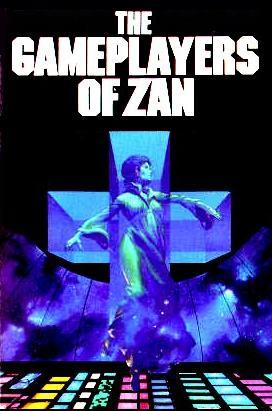
— John Murphy at Bardolatry.com on November 21, 2008
A vast library…
On searching for Garden of Eden patterns (GEP's):
"The grid is a staircase to the Universal…."
— Rosalind Krauss, quoted here on Weyl's birthday, 2004
"I find the whole topic of GEPs a deeply interesting one, from many viewpoints: mathematical, philosophical, physical….
… the obvious problem is, that the required computational time is growing rapidly with the size of the grid, and even for a small grid, like 4×4 (=16 cells) there are 216=65536 possible patterns…."
— cateye at RichardDawkins.net
… and magical powers
The date of cateye's post was Sunday, October 21, 2007.
For related material see Log24 on Sunday, October 21, 2007.
Monday, May 21, 2007
Monday May 21, 2007
Up Staircase
Commentary on a
Jonathan Borofsky
painting in the
May 21 New Yorker:
"… Mondrian and Malevich
are not discussing canvas
or pigment or graphite
or any other form of matter.
They are talking about about
Being or Mind or Spirit.
From their point of view,
the grid is a staircase
to the Universal…."
Tuesday, January 9, 2007
Tuesday January 9, 2007
(continued from
January 9, 2003)
George Balanchine
|
"What on earth is
a concrete universal?"
— Robert M. Pirsig
Review:
From Wikipedia's
"Upper Ontology"
and
Epiphany 2007:
"There is no neutral ground
that can serve as
a means of translating between
specialized (lower) ontologies."
There is, however,
"the field of reason"–
the 3×3 grid:
Click on grid
for details.
As Rosalind Krauss
has noted, some artists
regard the grid as
"a staircase to
the Universal."
Other artists regard
Epiphany itself as an
approach to
the Universal:
— Richard Kearney, 2005,
in The New Arcadia Review
Kearney (right) with
Martin Scorsese (left)
and Gregory Peck
in 1997.
— Richard Kearney, interview (pdf) in The Leuven Philosophy Newsletter, Vol. 14, 2005-2006
For more on "the possible," see Kearney's The God Who May Be, Diamonds Are Forever, and the conclusion of Mathematics and Narrative:
|
"We symbolize
logical necessity with the box and logical possibility with the diamond
"The possibilia that exist,
— Michael Sudduth, |
Saturday, January 6, 2007
Saturday January 6, 2007
Picture of Nothing
On Kirk Varnedoe’s
2003 Mellon Lectures,
“Pictures of Nothing“–
“Varnedoe’s lectures were ultimately
about faith, about his faith in
the power of abstraction,
and abstraction as a kind of
anti-religious faith in itself….”
Related material:
The more industrious scholars
will derive considerable pleasure
from describing how the art-history
professors and journalists of the period
1945-75, along with so many students,
intellectuals, and art tourists of every
sort, actually struggled to see the
paintings directly, in the old
pre-World War II way,
like Plato’s cave dwellers
watching the shadows, without
knowing what had projected them,
which was the Word.”
— Tom Wolfe, The Painted Word
“Concept (scholastics’ verbum mentis)–
theological analogy of Son’s procession
as Verbum Patris, 111-12″
— Index to Joyce and Aquinas,
by William T. Noon, S.J.,
Yale University Press 1957,
second printing 1963, page 162
“So did God cause the big bang?
Overcome by metaphysical lassitude,
I finally reach over to my bookshelf
for The Devil’s Bible.
Turning to Genesis I read:
‘In the beginning
there was nothing.
And God said,
‘Let there be light!’
And there was still nothing,
but now you could see it.'”
— Jim Holt, Big-Bang Theology,
Slate‘s “High Concept” department

“Bang.”
“…Mondrian and Malevich
are not discussing canvas
or pigment or graphite or
any other form of matter.
They are talking about
Being or Mind or Spirit.
From their point of view,
the grid is a staircase
to the Universal….”
For properties of the
“nothing” represented
by the 3×3 grid, see
The Field of Reason.
For religious material related
to the above and to Epiphany,
a holy day observed by some,
see Plato, Pegasus, and the
Evening Star and Shining Forth.
Sunday, November 26, 2006
Sunday November 26, 2006
Rosalind Krauss
in "Grids," 1979:
"If we open any tract– Plastic Art and Pure Plastic Art or The Non-Objective World, for instance– we will find that Mondrian and Malevich are not discussing canvas or pigment or graphite or any other form of matter. They are talking about Being or Mind or Spirit. From their point of view, the grid is a staircase to the Universal, and they are not interested in what happens below in the Concrete.
Or, to take a more up-to-date example…."
"He was looking at
the nine engravings
and at the circle,
checking strange
correspondences
between them."
— The Club Dumas,1993
"And it's whispered that soon
if we all call the tune
Then the piper will lead us
to reason."
— Robert Plant,1971
The nine engravings of
The Club Dumas
(filmed as "The Ninth Gate")
are perhaps more an example
of the concrete than of the
universal.
An example of the universal*–
or, according to Krauss, a
"staircase" to the universal–
is the ninefold square:

"This is the garden of Apollo,
the field of Reason…."
— John Outram, architect
For more on the field
of reason, see
Log24, Oct. 9, 2006.
A reasonable set of
"strange correspondences"
in the garden of Apollo
has been provided by Ezra Brown
in a mathematical essay (pdf).
Unreason is, of course,
more popular.
* The ninefold square is perhaps a "concrete universal" in the sense of Hegel:
"Two determinations found in all philosophy are the concretion of the Idea and the presence of the spirit in the same; my content must at the same time be something concrete, present. This concrete was termed Reason, and for it the more noble of those men contended with the greatest enthusiasm and warmth. Thought was raised like a standard among the nations, liberty of conviction and of conscience in me. They said to mankind, 'In this sign thou shalt conquer,' for they had before their eyes what had been done in the name of the cross alone, what had been made a matter of faith and law and religion– they saw how the sign of the cross had been degraded."
— Hegel, Lectures on the History of Philosophy, "Idea of a Concrete Universal Unity"
"For every kind of vampire,
there is a kind of cross."
— Thomas Pynchon
Monday, October 9, 2006
Monday October 9, 2006
To Apollo

“This is the garden of Apollo,
the field of Reason….”
John Outram, architect
To Apollo (10/09/02)
Art Wars: Apollo and Dionysus (10/09/02)
Balanchine’s Birthday (01/09/03)
Art Theory for Yom Kippur (10/05/03)
A Form (05/22/04)
Ineluctable (05/27/04)
A Form, continued (06/05/04)
Parallelisms (06/06/04)
Ado (06/25/04)
Deep Game (06/26/04)
Gameplayers of Zen (06/27/04)
And So To Bed (06/29/04)
Translation Plane for Rosh Hashanah (09/15/04)
Derrida Dead (10/09/04)
The Nine (11/09/04)
From Tate to Plato (11/19/04)
Art History (05/11/05)
A Miniature Rosetta Stone (08/06/05)
High Concept (8/23/05)
High Concept, Continued (8/24/05)
Analogical Train of Thought (8/25/05)
Today’s Sermon: Magical Thinking (10/09/05)
Balance (10/31/05)
Matrix (11/01/05)
Seven is Heaven, Eight is a Gate (11/12/05)
Nine is a Vine (11/12/05)
Apollo and Christ (12/02/05)
Hamilton’s Whirligig (01/05/06)
Cross (01/06/06)
On Beauty (01/26/06)
Sunday Morning (01/29/06)
Centre (01/29/06)
New Haven (01/29/06)
Washington Ballet (02/05/06)
Catholic Schools Sermon (02/05/06)
The Logic of Apollo (02/05/06)
Game Boy (08/06/06)
Art Wars Continued: The Krauss Cross (09/13/06)
Art Wars Continued: Pandora’s Box (09/16/06)
The Pope in Plato’s Cave (09/16/06)
Today’s Birthdays (09/26/06)
Symbology 101 (09/26/06)
Saturday, September 16, 2006
Saturday September 16, 2006
Pandora's Box
Part I:
The Pandora Cross
— Rosalind Krauss in "Grids"

Part II:
The Opening
Remarks by the Pope on Sept. 12,
as reported by the Vatican:
Faith, Reason, and the University:
Memories and Reflections
For the result of
the Pope's remarks, see
a transcript of
yesterday's Google News
and the following
from BBC today:

Click to enlarge the screenshot.
Part III:
Hope
"In September [2005], she had a private audience with Pope Benedict XVI at Castel Gandolfo, his summer residence outside Rome. She had criticized John Paul II for making overtures to Muslims, and for not condemning terrorism heartily enough, but she has hopes for Joseph Ratzinger."
For further details, see yesterday's Log24.
Part IV:
The Sibyl's Song
— From The Magic Circle,
a spiritual narrative
by Katherine Neville
For more on "the long-mute voice
of the past," on "darkness beneath
the volcano," and on uncorking,
see Glory Season and Harrowing.
Related material from
Log24 on Dec. 2, 2005:
Benedict XVI, before he became Pope:

and a related
Christian symbol,

the Greek Cross
(adapted from
Ad Reinhardt).
Moral of the Pandora Cross:
"Nine is a very powerful Nordic number."
— Katherine Neville in The Magic Circle…
quoted in The Nine, a Log24 entry
for Hermann Weyl's birthday,
November 9, 2004.
Wednesday, September 13, 2006
Wednesday September 13, 2006
The Krauss Cross
"If we open any tract– Plastic Art and Pure Plastic Art or The Non-Objective World, for instance– we will find that Mondrian and Malevich are not discussing canvas or pigment or graphite or any other form of matter. They are talking about Being or Mind or Spirit. From their point of view, the grid is a staircase to the Universal, and they are not interested in what happens below in the Concrete.
Or, to take a more up-to-date example, we could think about Ad Reinhardt who, despite his repeated insistence that 'Art is art,' ended up by painting a series of black nine-square grids in which the motif that inescapably emerges is a Greek cross. There is no painter in the West who can be unaware of the symbolic power of the cruciform shape and the Pandora's box of spiritual reference that is opened once one uses it."
Rebecca Goldstein on
Mathematics and Narrative:
"I don't write exclusively on Jewish themes or about Jewish characters. My collection of short stories, Strange Attractors, contained nine pieces, five of which were, to some degree, Jewish, and this ratio has provided me with a precise mathematical answer (for me, still the best kind of answer) to the question of whether I am a Jewish writer. I am five-ninths a Jewish writer."
Jacques Maritain,
October 1941:
"The passion of Israel
today is taking on
more and more distinctly
the form of the Cross."
E. L. Doctorow,
City of God:
"In the garden of Adding,
Live Even and Odd."
Friday, August 4, 2006
Friday August 4, 2006
ART WARS
continued from
previous entry
In memory of
Elisabeth Schwarzkopf:
This question might
well be posed by…

Rosalind Krauss,
Meyer Schapiro Professor
of Modern Art and Theory
at Columbia University
(Ph.D., Harvard U., 1969).
"The grid is a staircase to the Universal….
We could think about Ad Reinhardt, who,
despite his repeated insistence that
'Art is art,'
ended up by painting a series of…
nine-square grids in which the motif
that inescapably emerges is
a Greek cross.

Adapted from
Ad Reinhardt
There is no painter in the West
who can be unaware of
the symbolic power
of the cruciform shape and the
Pandora's box of spiritual reference
that is opened once one uses it."
— Rosalind Krauss in "Grids"
"Nine is a very powerful Nordic number."
— Katherine Neville, author of The Eight
Related material:
Saturday, July 30, 2005
Saturday July 30, 2005
Born today: Arnold Schwarzenegger
Frame not included in
Terminator 2: Judgment Day
"…Mondrian and Malevich are not
discussing canvas or pigment or graphite
or any other form of matter.
They are talking about
Being or Mind or Spirit.
From their point of view, the grid
is a staircase to the Universal…."
— Rosalind Krauss, "Grids"
Saturday July 30, 2005
Born today: Hilary Swank

"The grid is a staircase to the Universal."
— Rosalind Krauss
"To live is to defend a form."
— attributed to Hölderlin
Sunday, June 19, 2005
Sunday June 19, 2005
Darkness Visible
Serv'd only to discover sights of woe"
— John Milton, Paradise Lost,
Book I, lines 63-64
summarizes the art of Ad Reinhardt
(Adolph Dietrich Friedrich Reinhardt,
Dec. 24, 1913 – Aug. 30, 1967):
|
Fade to Black "…that ineffable constellation of talents that makes the player of rank: a gift for conceiving abstract schematic possibilities; a sense of mathematical poetry in the light of which the infinite chaos of probability and permutation is crystallized under the pressure of intense concentration into geometric blossoms; the ruthless focus of force on the subtlest weakness of an opponent." — Trevanian, Shibumi "'Haven't there been splendidly elegant colors in Japan since ancient times?' 'Even black has various subtle shades,' Sosuke nodded." — Yasunari Kawabata, The Old Capital
An Ad Reinhardt painting
Ad Reinhardt,
The viewer may need to tilt "The grid is a staircase to the Universal…. We could think about Ad Reinhardt, who, despite his repeated insistence that 'Art is art,' ended up by painting a series of… nine-square grids in which the motif that inescapably emerges is a Greek cross. 
Greek Cross There is no painter in the West who can be unaware of the symbolic power of the cruciform shape and the Pandora's box of spiritual reference that is opened once one uses it."
— Rosalind Krauss,
|
In memory of
St. William Golding
(Sept. 19, 1911 – June 19, 1993)
Saturday, May 14, 2005
Saturday May 14, 2005
continued
“Horton Marlais Davies, Putnam professor emeritus of religion at Princeton and an author of many books about church history, died on Wednesday at his home in Princeton, N.J. He was 89…. Dr. Davies specialized in the impact of Christianity on the arts.”
apparently first published by Eerdmans
at Grand Rapids, Michigan, in 1990
The Catholic Encyclopedia (1908) on the communion of saints:
“One cannot read the parables of the kingdom (Matt., xiii) without perceiving its corporate nature and the continuity which links together the kingdom in our midst and the kingdom to come. The nature of that communion, called by St. John a fellowship with one another (‘a fellowship with
Related material:
Religious art in the entry Art History of 11 AM Wednesday, May 11, the date of Davies’s death. See also the following direct and indirect links from that entry:
To a cruciform artifact from the current film Kingdom of Heaven, to an entry quoting John xv, Nine is a Vine, and to Art Theory for Yom Kippur.
For less-religious material on the number nine, see the entries and links in the Log24 archive for June 17-30, 2004.

“If we open any tract–
Plastic Art and Pure Plastic Art
or The Non-Objective World,
for instance– we will find that
Mondrian and Malevich are not
discussing canvas or pigment or
graphite or any other form of
matter. They are talking about
Being or Mind or Spirit.”
Amen.
Sunday, May 1, 2005
Sunday May 1, 2005
Harvard's Barry Mazur on
one mathematical style:
"It’s the barest, most Beckett-like vocabulary
that incorporates the theory and nothing else."
Samuel Beckett, Quad (1981):

A Jungian on this six-line logo:
"They are the same six lines
that exist in the I Ching….
Now observe the square more closely:
four of the lines are of equal length,
the other two are longer….
For this reason symmetry
cannot be statically produced
and a dance results."
— Marie-Louise von Franz,
Number and Time (1970),
Northwestern U. Press
paperback, 1979, p. 108
A related logo from
Columbia University's
Department of Art History
and Archaeology:

Also from that department:

Meyer Schapiro Professor
of Modern Art and Theory:
"There is no painter in the West
who can be unaware of
the symbolic power
of the cruciform shape
and the Pandora's box
of spiritual reference
that is opened
once one uses it."
"In the garden of Adding
live Even and Odd…"
— The Midrash Jazz Quartet in
City of God, by E. L. Doctorow
THE GREEK CROSS
are the same length.
Here, for reference, is a Greek cross
within a nine-square grid:

Related religious meditation for
Doctorow's "Garden of Adding"…
Types of Greek cross
illustrated in Wikipedia
under "cross":

THE BAPTISMAL CROSS

a Greek cross, which is superimposed
on a Greek 'chi,' the first letter
of the Greek word for 'Christ.'
Since the number eight is symbolic
of rebirth or regeneration,
this cross is often used
as a baptismal cross.
Related material:

Fritz Leiber's "spider"
or "double cross" logo.
See Why Me? and
A Shot at Redemption.
Happy Orthodox Easter.
Tuesday, November 9, 2004
Tuesday November 9, 2004
The Nine
(Readings for
Weyl’s birthday)
“The grid is a staircase to the Universal….
We could think about Ad Reinhardt, who,
despite his repeated insistence that
‘Art is art,’
ended up by painting a series of…
nine-square grids in which the motif
that inescapably emerges is
a Greek cross.

Greek Cross
There is no painter in the West
who can be unaware of
the symbolic power
of the cruciform shape and the
Pandora’s box of spiritual reference
that is opened once one uses it.”
— Rosalind Krauss,
Meyer Schapiro Professor
of Modern Art and Theory
at Columbia University
(Ph.D., Harvard U., 1969),
in “Grids”

“Nine is a very powerful Nordic number.”
— Katherine Neville, author of The Eight,

in The Magic Circle,
Ballantine paperback,
1999, p. 339

“To live is to defend a form.”
(“Leben, das heisst eine Form verteidigen“)
— attributed to Hölderlin

For details on the above picture,
which deals with properties of the
nine-square grid, see
For more on the defense
of this form,

see the Log24.net entry of
June 5, 2004, A Form,
and the Art Wars entries
for St. Peter’s Day, 2004.
Tuesday, October 7, 2003
Tuesday October 7, 2003
ART WARS:
Judgment Day
“…Mondrian and Malevich are not discussing canvas or pigment or graphite or any other form of matter. They are talking about Being or Mind or Spirit. From their point of view, the grid is a staircase to the Universal….”
— Rosalind Krauss, “Grids”
Krauss is the Meyer Schapiro Professor of Modern Art and Theory at Columbia University.
For more on Meyer Schapiro, see the link on the phrase “art historian” in my March 10, 2003, entry.
To view that entry in a larger context, see the web page Art at the Vanishing Point, which includes a picture of Mondrian’s own Paris staircase. The picture below might be thought of as illustrating Krauss’s “grid is a staircase”… a staircase to, in fact, a vanishing point.
Frame not included in
Terminator 2: Judgment Day
For a different view of what the New York Times Book Review has characterized as “high culture,” see the link on that phrase also in my March 10, 2003, entry. This leads to a work by T. S. Eliot titled Christianity and Culture. See too the remarks of the Meyer Schapiro Professor in my Oct. 5, 2003, entry, “Art Theory for Yom Kippur,” in which she likens the Cross to Pandora’s box.
Eliot’s attitude toward this Jewish approach to high culture might be summarized by the following remarks of Sarah Connor in Terminator 2: Judgment Day—
Dr. Silberman: You broke my arm!
Sarah Connor: There are two-hundred-fifteen bones in the human body, [expletive deleted]. That’s one.
Sunday, October 5, 2003
Sunday October 5, 2003
At Mount Sinai:
Art Theory for Yom Kippur
From the New York Times of Sunday, October 5, 2003 (the day that Yom Kippur begins at sunset):
“Rabbi Ephraim Oshry, whose interpretations of religious law helped sustain Lithuanian Jews during Nazi occupation…. died on Sept. 28 at Mount Sinai Hospital in Manhattan. He was 89.”
For a fictional portrait of Lithuanian Jews during Nazi occupation, see the E. L. Doctorow novel City of God.
For meditations on the spiritual in art, see the Rosalind Krauss essay “Grids.” As a memorial to Rabbi Oshry, here is a grid-based version of the Hebrew letter aleph:
|
|
Click on the aleph for details.
“In the garden of Adding,
Live Even and Odd….”
— The Midrash Jazz Quartet in
City of God, by E. L. Doctorow
Here are two meditations
on Even and Odd for Yom Kippur:
Meditation I
From Rosalind Krauss, “Grids”:
“If we open any tract– Plastic Art and Pure Plastic Art or The Non-Objective World, for instance– we will find that Mondrian and Malevich are not discussing canvas or pigment or graphite or any other form of matter. They are talking about Being or Mind or Spirit. From their point of view, the grid is a staircase to the Universal, and they are not interested in what happens below in the Concrete.
Or, to take a more up-to-date example, we could think about Ad Reinhardt who, despite his repeated insistence that ‘Art is art,’ ended up by painting a series of black nine-square grids in which the motif that inescapably emerges is a Greek cross. There is no painter in the West who can be unaware of the symbolic power of the cruciform shape and the Pandora’s box of spiritual reference that is opened once one uses it.”
Meditation II
Here, for reference, is a Greek cross
within a nine-square grid:

Related religious meditation for
Doctorow’s “Garden of Adding”…
Friday, October 3, 2003
Friday October 3, 2003
ART WARS:
Time and the Grid
Art theorist Rosalind Krauss and poet T. S. Eliot on time, timelessness, and the grid.









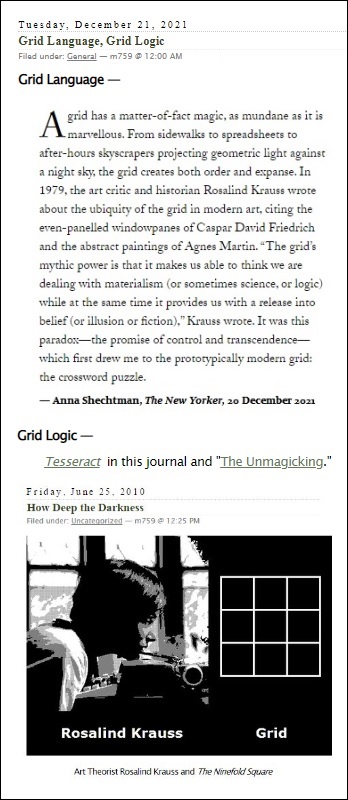





.jpg)
